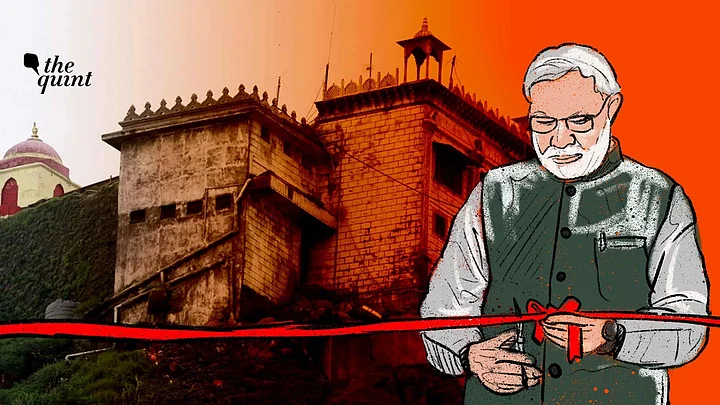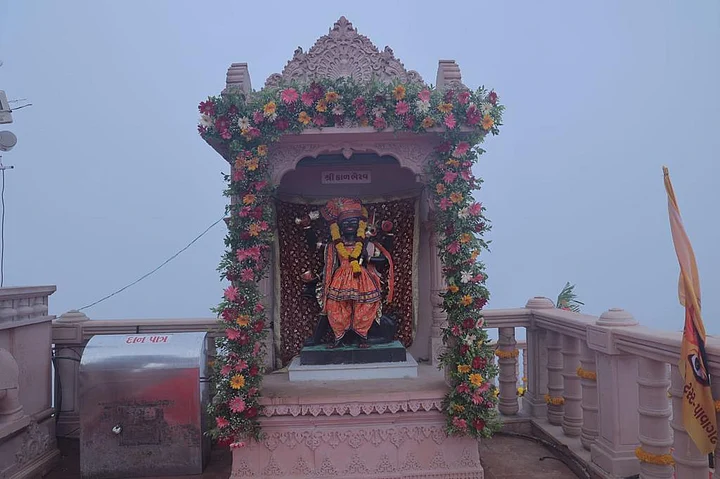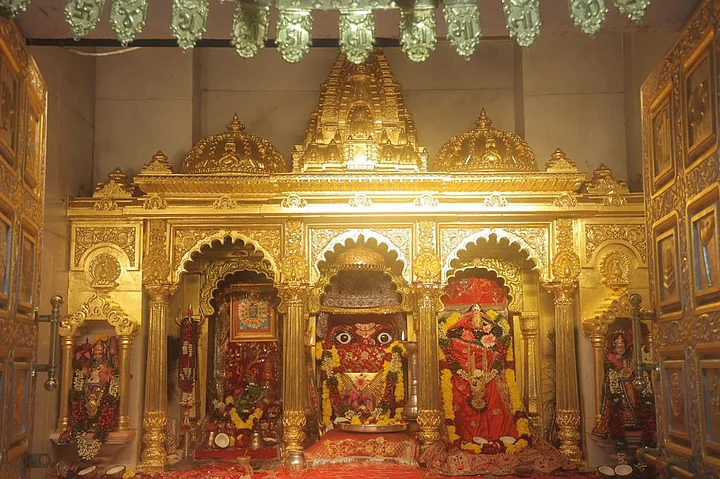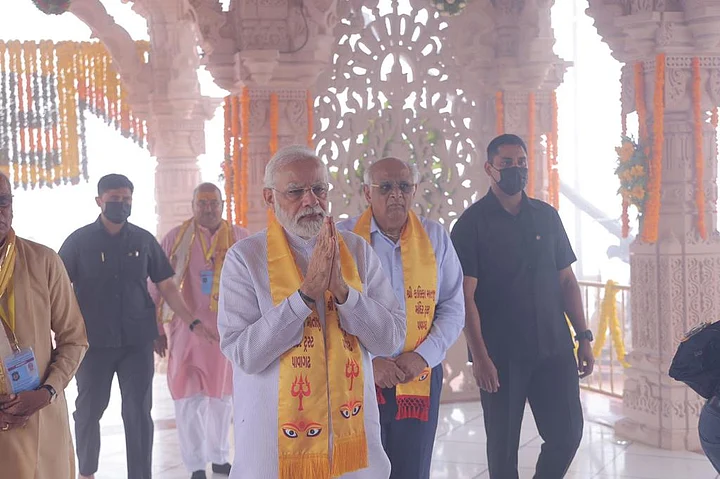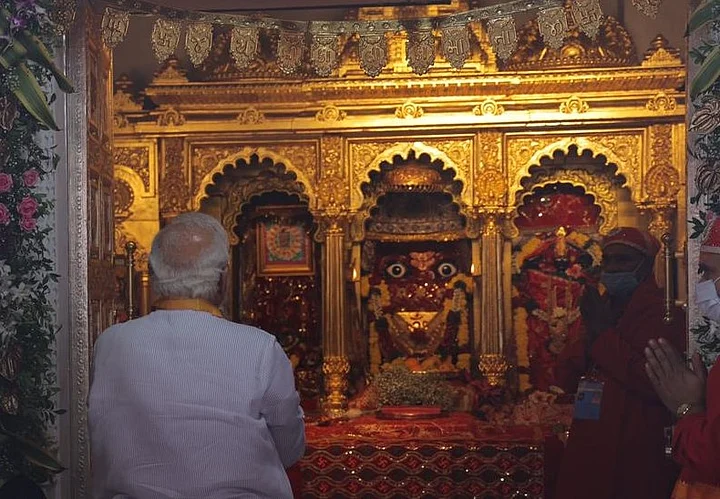On 18 June, Prime Minister Narendra Modi inaugurated a redeveloped Mahakali Temple on Pavagarh Hill in Gujarat's Panchmahal district. Calling the temple a "symbol of religious unity", the prime minister said that "India is reclaiming its cultural treasures" as he unfurled a flag on the superstructure of the temple.
Dedicated to Kalika Mata, a Hindu goddess, the temple dates back to the 10th century. It is situated inside the Champaner-Pavagadh Archaeological Park – a UNESCO World Heritage site – and is also known as the Mahakali Temple or the Pavagarh Temple.
Interestingly, a dargah (shrine) which stood atop the garbhagriha (sanctum sanctorum) of temple, has been relocated to another place within the temple premises as part of the redevelopment. "The relocation happened rather amicably and with permission of the Muslim caretakers of the shrine," Dr Parag Pandya, one of the temple trustees told The Quint.
The dargah built in the 15th century under the rule of Mahmud Begada – one of the prominent rulers of the Gujarat Sultanate – is dedicated to Hazrat Sadanshah, a Sufi saint in the court of Muhammad Shah, Mahmud Begada's father.
PM Modi in his speech, however, made no reference to shifting of the shrine. "Can you imagine that for five centuries and decades of independence, no flag had been unfurled on the shikhar of goddess Kali? It has happened now. New India is re-establishing its lost cultural history,” he said.
What is the historical significance of the Pavagarh Mahakali temple? Who built the shrine atop it? Why is the temple politically relevant today? The Quint spoke to temple officials, historians, and art curators to find out more–.
The Relevance of the Temple
The Kalika Mata Temple is an important pilgrimage site for lakhs of devotees across Gujarat who flock to the temple to mark the festival of Navaratri.
As Gujarat gears up for Assembly elections later this year, the inauguration of the temple is a key political development as far as the ruling Bharatiya Janata Party (BJP) is concerned. The city of Champaner where Pavagarh temple is situated is part of the Panchmahal district in Gujarat's tribal belt.
While tribals are not the only devotees who visit the temple, Sandhya Gajjar, a Gujarat-based writer and independent art curator, points out that Pavagarh is a pilgrimage site for the poor people of the state.
"One reason why the redevelopment of Pavagarh was ignored for far too long was because it's a pilgrimage of the poor. It is located in the tribal heartland of Gujarat. While all devotees of the goddess are not tribals, they are mostly poor people," she says.
Tribals hold a considerable sway in Gujarat accounting for 15 percent of the state's population. In the 2017 Assembly elections, the Congress won 15 out of 27 Assembly seats reserved for the Scheduled Tribes in the state. The BJP won nine, while two seats went to the Bharatiya Tribal Party (BTP) and one seat was won by an independent candidate.
In a bid to win over the tribal votes, the Modi government had earlier scrapped its ambitious Par-Tapi-Narmada river-link Project which was being opposed by the local residents – mostly tribals.
Further, with the BTP joining hands with Arvind Kejriwal's Aam Aadmi Party in May 2021, it only makes sense for the BJP to up the ante in the belt.
Pavagarh Temple – The History and The Legend
The Pavagarh temple finds mention in several historical accounts detailing the city of Champaner, which for a very brief time was the capital of the Gujarat Sultanate – a medieval kingdom established in the 15th century in the present-day state of Gujarat.
The city of Champaner was founded by Vanraj Chavda of the Chavda dynasty in the 8th century, and it was attacked, destroyed, rebuilt, and embellished by Sultan Mahmud Begada in the 15th century. Begada also moved the capital of the Sultanate from Ahmedabad to Champaner sometime around 1511.
In his book Champaner — A Medieval Capital, Gujarat-based archaeologist Professor RN Mehta writes that the Kalika Mata temple was situated at the highest point of the Pavagarh Hill and finds exhaustive mention in 15th century literature including a drama titled 'Gangadas Pratap Vilas Nataka'.
"It (Kalika Mata temple) is a well-known Shakti Pith (significant pilgrimage destinations as per the medieval Hindu tradition of Shaktism) in Gujarat. As per religious texts, it is said that the temple stands on the spot where the right toe of the goddess Kalika fell," Mehta writes in his book.
As per a note put out by the temple trust, Mahmud Begada destroyed the superstructure of the temple after conquering Champaner in 1484. Few decades later, in 1511, he built the shrine of Hazrat Sadanshah atop the Kalika Mata Temple.
The Champaner-Pavagarh Archaeological Park was inscribed as a UNESCO World Heritage Site in 2004.
"If you have read the history of Gujarat, you would know that a ruler named Mahmud Begada destroyed many Hindu temples after he made Champaner the capital of his empire. Even 70 years after Independence and 500 years after his rule we were unable to restore the temple. We feel proud that it has happened now."Parag Pandya, Pavagarh Temple Trustee
According to accounts by European travellers which date back to the 15th century, Begada was an able administrator and a successful conqueror with a "strong religious zeal". Several Hindu poets, however, continued to flourish under his rule. One of them was Udayaraja – his court poet.
As per claims by Duarte Barbosa, a European traveller in the 16th century, Begada consumed poison in measured doses since early in his childhood which made him popular as Gujarat's 'poison king'. It is believed that the emperor did so to kill the opponents with his "poisonous saliva".
Sandhya Gajjar and her group in their book titled Myths and Legends of Champaner-Pavagarh, documented the oral history of the temple as heard from the locals in Champaner.
"It is believed that there was a Hindu princess in a nearby area and the Sultan at Champaner was threatening to attack her kingdom. She asked emperor Humayun of the Mughal dynasty for help by making him her rakhi brother. Humayun ransacked the entire city leaving only the religious monuments on the ground," she claims.
Gajjar says, "When you visit Pavagarh or Champaner, you will see eclectic mix of domes and minarets seen in Islamic architecture and arches which are very Jain and Hindu in nature."
As per local folklore documented by Gajjar and her group, the Kalika temple was formed after Lord Shiva's wife Sati jumped into the sacrificial fire after which her body was cut into 51 pieces, all of which landed on different mountain tops. "As per folklore, Pavagarh is where Sati's right toe landed," says Gajjar.
The Redevelopment
While inaugurating the temple, PM Modi compared it with the Ram temple in Ayodhya and the Vishwanath Dham in Varanasi, a point also reiterated by temple's trustee, Parag Pandya.
"Even when he (Narendra Modi) was the chief minister of Gujarat, he always focused on reclaiming and restoring symbols of our faith. The redevelopement of the temple was given a green signal when Anandiben Patel took over as the state's CM after Modi ji was elected the PM in 2014," he said.
The redevelopment was carried out by Ahmedabad-based architect Ashish Sompura, who is building the Ram temple in Ayodhya.
"The Pavagadh climb is not difficult but in certain places the path narrows and in times of the Chaitri Navratri (in April) and the regular Navratri (in September October) the rush of pilgrims is unbelievable, sometimes causing accidents. Granite and marble are not always the best flooring," Gajjar told The Quint.
As per Pandya, the redevelopment used around 3,600 cubic feet of red sandstone from Rajasthan, the same that is being used to build the Ram temple at Ayodhya.
- 01/04
Red sandstone from Rajasthan has been used to revamp the temple.
(Photo: Twitter/Gujarat BJP)

- 02/04
Inside the revamped temple.
(Photo: Twitter/Gujarat BJP)

- 03/04
Prime Minister Modi and Gujarat Chief Minister Bhupendra Patel at the Pavagarh Mahakali Temple.
(Photo: Twitter/Gujarat BJP)

- 04/04
Prime Minister Modi prays at the Pavagarh Mahakali Temple.
(Photo: Twitter/Gujarat BJP)

In March 2018, the diwan (treasury official) administering the dargah moved the Gujarat High court against the state's tourism department as well as the temple trust. In 2019, however, the diwan submitted a petition saying that the matter will be solved out of court. This came after the temple trustees decided to allocate a separate place for the dargah within the temple premises.
The Quint tried reaching out to the family of the diwan who remained unavailable for comments despite multiple attempts.
"It depends on how one approaches the matter. We settled the issue regarding the dargah amicably outside the court. Else this could have become a matter of religious polarisation. That was not our intent. We just wanted our temple to be restored," Pandya, the temple trustee, told The Quint.
At least 70 percent of the total cost of renovation (Rs 125 crore) was borne by the Gujarat government’s Pavitra Yatradham Vikas Board (GPYVB) while the remaining 30 percent was borne by the temple trust.
